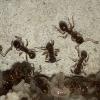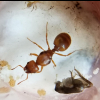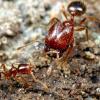This is my first proper recording of my ants so I thought I would share it.
Can you guess what the 2 species are in the video? I'm pretty convinced that the dark spindly ones with the relaxed gait are Aphaenogaster, but a friend of mine thinks they're also Myrmica.
The insect they're eating is a wild cricket I found.
If you pay attention, you may notice that there's an ant with 1 antenna. This one consistently exhibits bullying behaviours towards the other species, sometimes dragging them to the trash pile or cramming them in the water feeder. I've noticed that only a few members of the colony seem to even pay attention to the guests.

















